light SUBARU OUTBACK 2005 4.G User Guide
[x] Cancel search | Manufacturer: SUBARU, Model Year: 2005, Model line: OUTBACK, Model: SUBARU OUTBACK 2005 4.GPages: 627, PDF Size: 6.42 MB
Page 30 of 627

27
–
CONTINUED –
Windshield wiper deicer (if
equipped) Windshield wiper deicer Operation for 15 min. / Continuous
operationOperation for15 min.3-56
Dome light Operation in interlock with remote keyless entry system OFF / Short / Normal / Long Normal 6-2
Battery drainage prevention
function Battery drainage prevention func-tion Operation / Non-operation Operation 2-9
Item Function Possible settings Default set-
tingPage
Page 32 of 627

1-1
1
Seat, seatbelt and SRS airbags
Front seats .................................................... 1-2 Manual seat ....................................................... 1-3
Power seat (if equipped) .................................. 1-5
Reclining the seatback ..................................... 1-6
Head restraint adjustment ................................ 1-8
Active head restraint ........................................ 1-8
Lumbar support (if equipped) .......................... 1-9
Seat heater (if equipped) .............................. 1-10
Rear seats ..................................................... 1-11 Folding down the rear seat – Station wagon .. 1-12
Head restraint adjustment ................................ 1-12
Armrest (if equipped) ................................... 1-14 Loading long objects (Sedan) .......................... 1-15
Seatbelts ....................................................... 1-16 Seatbelt safety tips ........................................... 1-16
Emergency Locking Retractor (ELR) .............. 1-18
Automatic/Emergency Locking Retractor (A/ELR) ............................................................ 1-18
Seatbelt warning light and chime .................... 1-19
Fastening the seatbelt ...................................... 1-21
Seatbelt maintenance ....................................... 1-33
Front seatbelt pretensioners ....................... 1-33 System monitors ............................................... 1-35
System servicing .............................................. 1-36
Precautions against vehicle modification ...... 1-37
Child restraint systems ................................ 1-38 Where to place a child restraint system ......... 1-40
Choosing a child restraint system .................. 1-41
Installing child restraint systems with A/ELR seatbelt ............................................................ 1-42 Installing a booster seat ................................... 1-47
Installation of child restraint systems by use
of lower and tether anchorages (LATCH) .... 1-49
Top tether anchorages ..................................... 1-55
*SRS airbag (Supplemental Restraint System airbag) ........................................... 1-59Vehicle with SRS airbags and lap/shoulder restraints for driver, front passenger, and
window-side rear passengers ....................... 1-59
Subaru advanced frontal airbag system ........ 1-65
SRS side airbag and SRS curtain airbag ........ 1-80
SRS airbag system monitors ........................... 1-89
SRS airbag system servicing .......................... 1-91
Precautions against vehicle modification ...... 1-92
Page 34 of 627
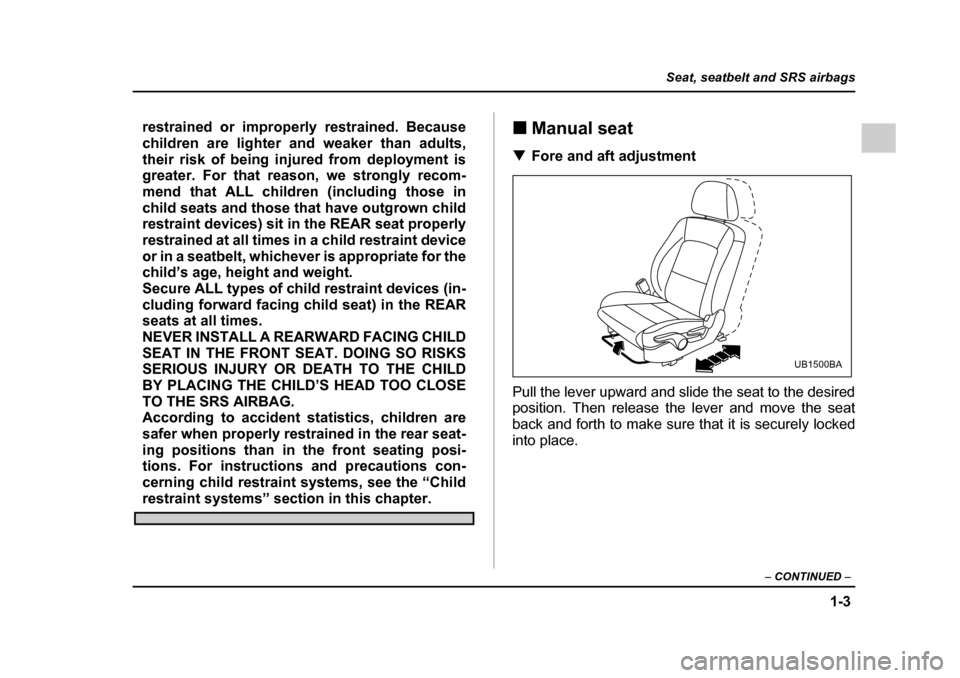
1-3
Seat, seatbelt and SRS airbags
– CONTINUED –
restrained or improperly restrained. Because
children are lighter and weaker than adults,
their risk of being injured from deployment is
greater. For that reason, we strongly recom-
mend that ALL children (including those in
child seats and those that have outgrown child
restraint devices) sit in the REAR seat properly
restrained at all times in a child restraint device
or in a seatbelt, whichever is appropriate for the
child’s age, height and weight.
Secure ALL types of child restraint devices (in-
cluding forward facing child seat) in the REAR
seats at all times.
NEVER INSTALL A REARWARD FACING CHILDSEAT IN THE FRONT SEAT. DOING SO RISKS
SERIOUS INJURY OR DEATH TO THE CHILD
BY PLACING THE CHILD’S HEAD TOO CLOSE
TO THE SRS AIRBAG.
According to accident statistics, children are
safer when properly restrained in the rear seat-
ing positions than in the front seating posi-
tions. For instructions and precautions con-
cerning child restraint systems, see the “Child
restraint systems” section in this chapter. !
Manual seat
! Fore and aft adjustment
Pull the lever upward and slide the seat to the desired
position. Then release the lever and move the seat
back and forth to make sure that it is securely locked
into place.
UB1500BA
Page 35 of 627
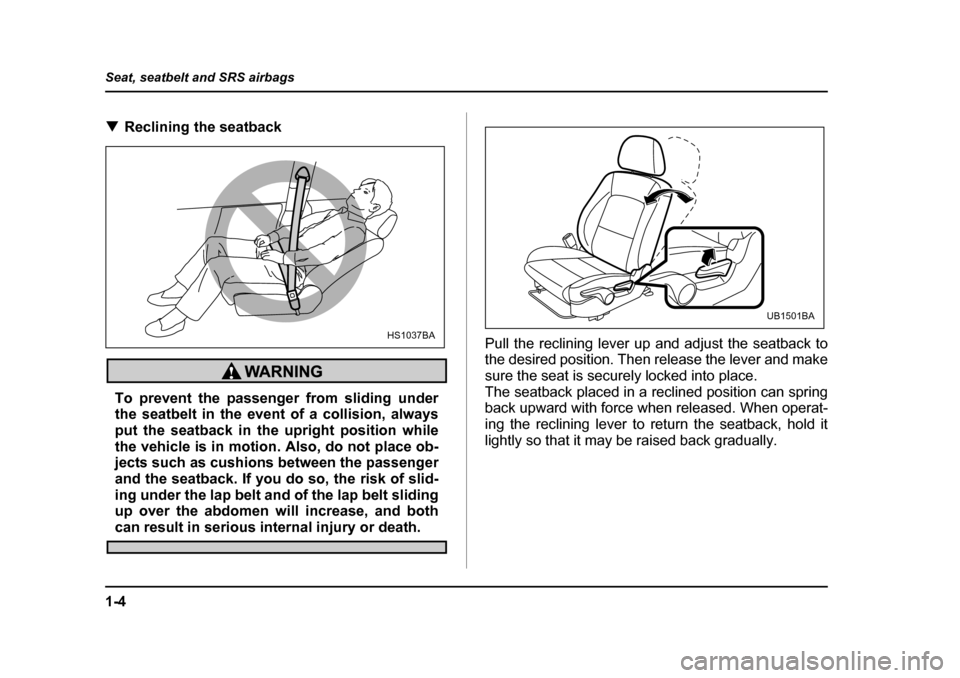
1-4
Seat, seatbelt and SRS airbags
!
Reclining the seatback
To prevent the passenger from sliding under
the seatbelt in the event of a collision, alwaysput the seatback in the upright position while
the vehicle is in motion. Also, do not place ob-
jects such as cushions between the passenger
and the seatback. If you do so, the risk of slid-
ing under the lap belt and of the lap belt sliding
up over the abdomen will increase, and both
can result in serious internal injury or death. Pull the reclining lever up and adjust the seatback to
the desired position. Then release the lever and make
sure the seat is securely locked into place.
The seatback placed in a reclined position can spring
back upward with force when released. When operat-
ing the reclining lever to return the seatback, hold it
lightly so that it may be raised back gradually.
HS1037BA
UB1501BA
Page 39 of 627
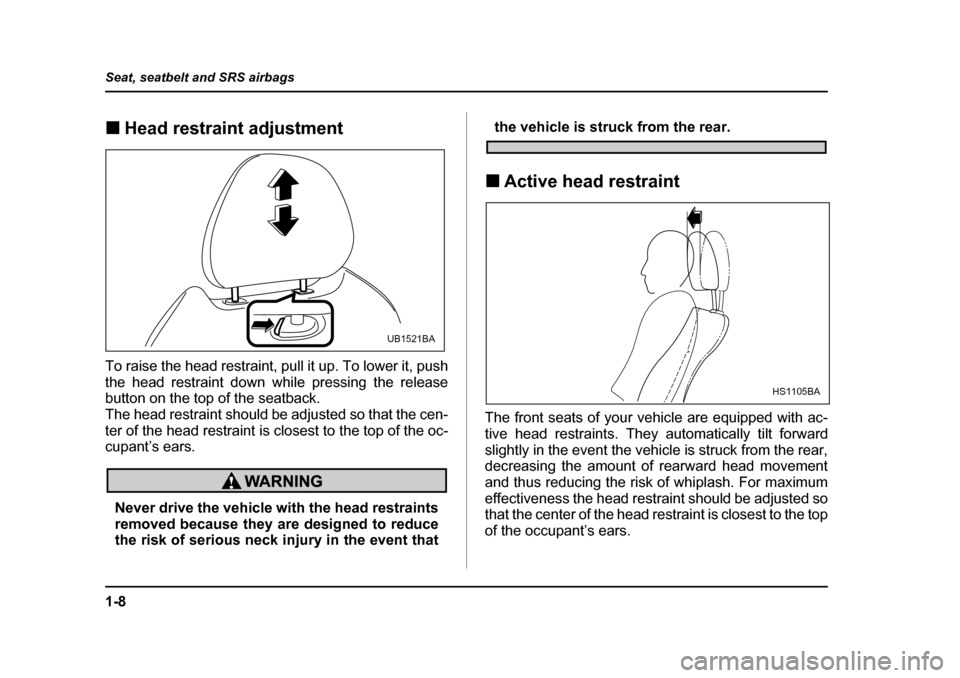
1-8
Seat, seatbelt and SRS airbags
!
Head restraint adjustment
To raise the head restraint, pull it up. To lower it, push
the head restraint down while pressing the release
button on the top of the seatback.
The head restraint should be adjusted so that the cen-
ter of the head restraint is closest to the top of the oc-
cupant’s ears.
Never drive the vehicle with the head restraints
removed because they are designed to reduce
the risk of serious neck injury in the event that
the vehicle is struck from the rear.
! Active head restraint
The front seats of your vehicle are equipped with ac-
tive head restraints. They automatically tilt forward
slightly in the event the vehicle is struck from the rear,
decreasing the amount of rearward head movement
and thus reducing the risk of whiplash. For maximum
effectiveness the head restraint should be adjusted so
that the center of the head restraint is closest to the top
of the occupant’s ears.
UB1521BA
HS1105BA
Page 40 of 627
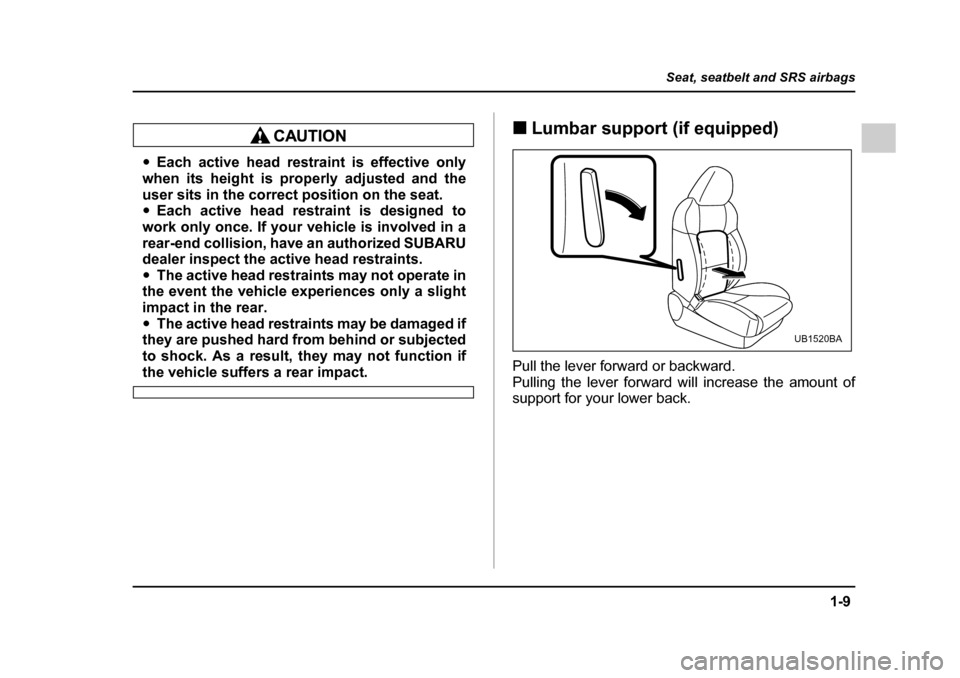
1-9
Seat, seatbelt and SRS airbags
– CONTINUED –
"Each active head restraint is effective only
when its height is properly adjusted and the
user sits in the correct position on the seat. " Each active head restraint is designed to
work only once. If your vehicle is involved in a
rear-end collision, have an authorized SUBARU
dealer inspect the active head restraints." The active head restraints may not operate in
the event the vehicle experiences only a slight
impact in the rear." The active head restraints may be damaged if
they are pushed hard from behind or subjected
to shock. As a result, they may not function if
the vehicle suffers a rear impact. !
Lumbar support (if equipped)
Pull the lever forward or backward.
Pulling the lever forward will increase the amount of
support for your lower back.
UB1520BA
Page 41 of 627
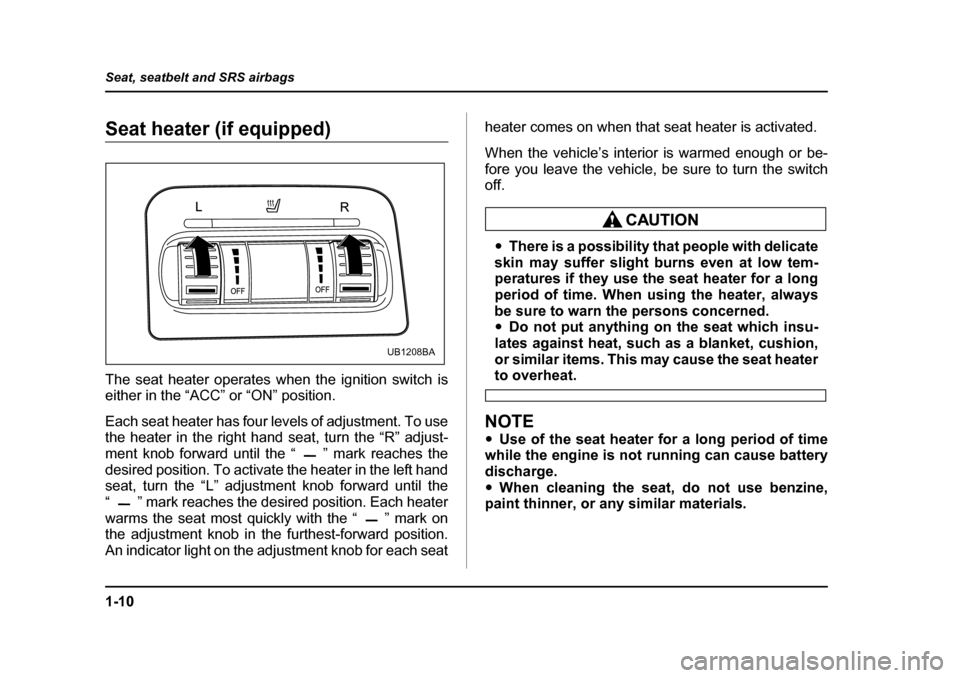
1-10
Seat, seatbelt and SRS airbags
Seat heater (if equipped)
The seat heater operates when the ignition switch is
either in the “ACC” or “ON” position.
Each seat heater has four levels of adjustment. To use
the heater in the right hand seat, turn the “R” adjust-
ment knob forward until the “ ” mark reaches the
desired position. To activate the heater in the left hand
seat, turn the “L” adjustment knob forward until the
“ ” mark reaches the desired position. Each heater
warms the seat most quickly with the “ ” mark on
the adjustment knob in the furthest-forward position.
An indicator light on the adjustment knob for each seat
heater comes on when that seat heater is activated.
When the vehicle’s interior is warmed enough or be-
fore you leave the vehicle, be sure to turn the switch
off.
"
There is a possibility that people with delicate
skin may suffer slight burns even at low tem-
peratures if they use the seat heater for a long
period of time. When using the heater, always
be sure to warn the persons concerned. " Do not put anything on the seat which insu-
lates against heat, such as a blanket, cushion,
or similar items. This may cause the seat heater
to overheat.
NOTE " Use of the seat heater for a long period of time
while the engine is not running can cause battery
discharge." When cleaning the seat, do not use benzine,
paint thinner, or any similar materials.
UB1208BA
Page 48 of 627
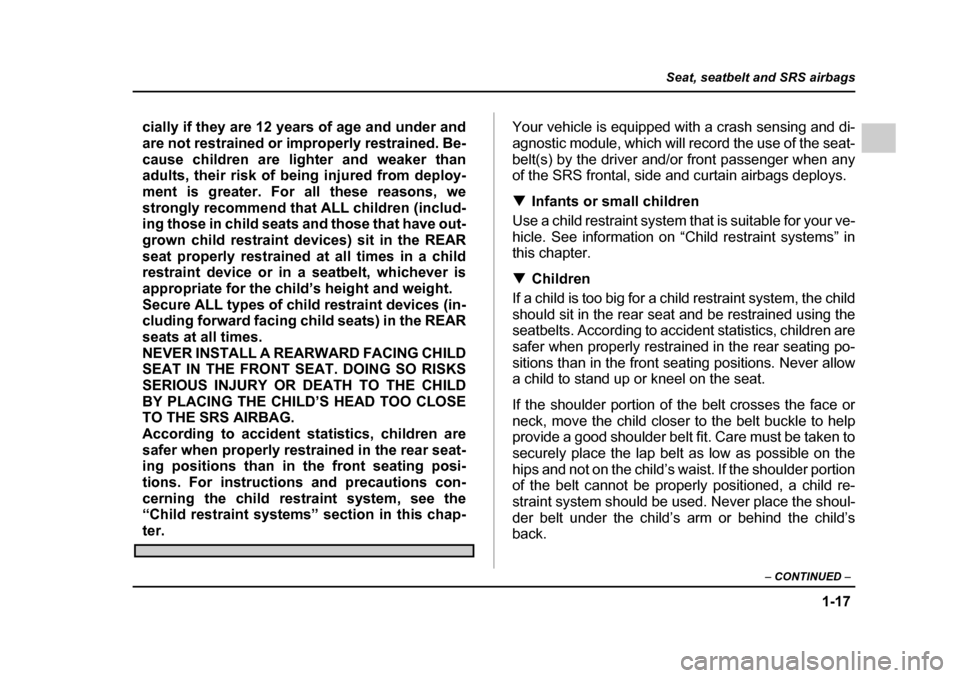
1-17
Seat, seatbelt and SRS airbags
– CONTINUED –
cially if they are 12 years of age and under and
are not restrained or improperly restrained. Be-
cause children are lighter and weaker than
adults, their risk of being injured from deploy-
ment is greater. For all these reasons, we
strongly recommend that ALL children (includ-
ing those in child seats and those that have out-
grown child restraint devices) sit in the REAR
seat properly restrained at all times in a child
restraint device or in a seatbelt, whichever is
appropriate for the child’s height and weight.
Secure ALL types of child restraint devices (in-
cluding forward facing child seats) in the REAR
seats at all times.
NEVER INSTALL A REARWARD FACING CHILD SEAT IN THE FRONT SEAT. DOING SO RISKS
SERIOUS INJURY OR DEATH TO THE CHILD
BY PLACING THE CHILD’S HEAD TOO CLOSE
TO THE SRS AIRBAG.
According to accident statistics, children are
safer when properly restrained in the rear seat-
ing positions than in the front seating posi-
tions. For instructions and precautions con-
cerning the child restraint system, see the
“Child restraint systems” section in this chap-
ter. Your vehicle is equipped with a crash sensing and di-
agnostic module, which will record the use of the seat-
belt(s) by the driver and/or front passenger when any
of the SRS frontal, side and curtain airbags deploys. !
Infants or small children
Use a child restraint system that is suitable for your ve-
hicle. See information on “Child restraint systems” in
this chapter. ! Children
If a child is too big for a child restraint system, the child
should sit in the rear seat and be restrained using the
seatbelts. According to accident statistics, children are
safer when properly restrained in the rear seating po-
sitions than in the front seating positions. Never allow
a child to stand up or kneel on the seat.
If the shoulder portion of the belt crosses the face or
neck, move the child closer to the belt buckle to help
provide a good shoulder belt fit. Care must be taken to
securely place the lap belt as low as possible on the
hips and not on the child’s waist. If the shoulder portion
of the belt cannot be properly positioned, a child re-
straint system should be used. Never place the shoul-
der belt under the child’s arm or behind the child’s back.
Page 49 of 627
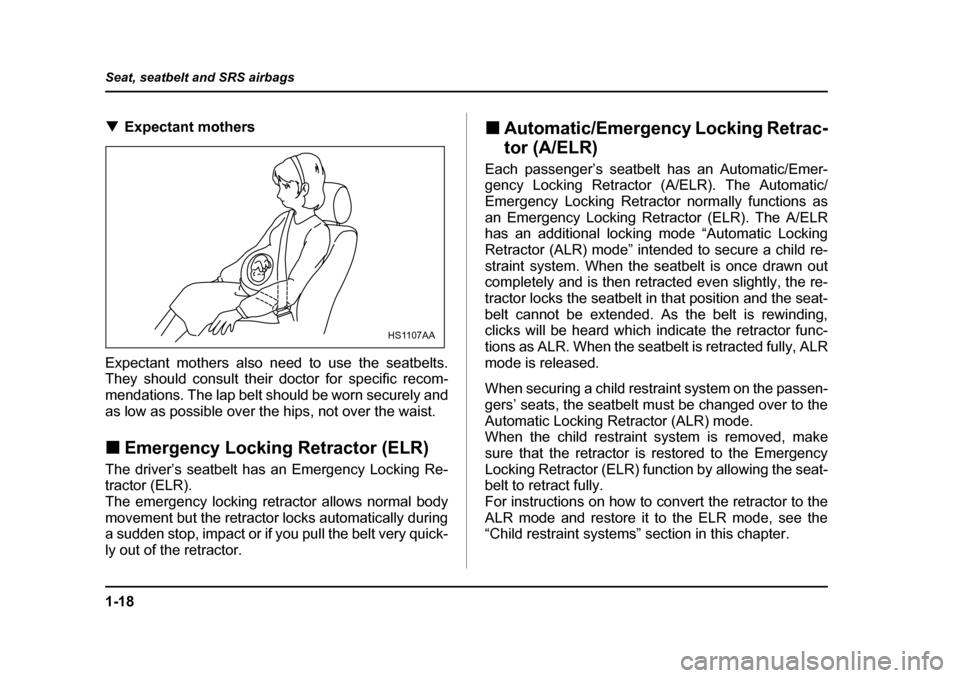
1-18
Seat, seatbelt and SRS airbags
!
Expectant mothers
Expectant mothers also need to use the seatbelts.
They should consult their doctor for specific recom-
mendations. The lap belt should be worn securely and
as low as possible over the hips, not over the waist. ! Emergency Locking Retractor (ELR)
The driver’s seatbelt has an Emergency Locking Re-
tractor (ELR).
The emergency locking retractor allows normal body
movement but the retractor locks automatically during
a sudden stop, impact or if you pull the belt very quick-
ly out of the retractor. !
Automatic/Emergency Locking Retrac- tor (A/ELR)
Each passenger’s seatbelt has an Automatic/Emer-
gency Locking Retractor (A/ELR). The Automatic/
Emergency Locking Retractor normally functions as
an Emergency Locking Retractor (ELR). The A/ELR
has an additional locking mode “Automatic Locking
Retractor (ALR) mode” intended to secure a child re-
straint system. When the seatbelt is once drawn out
completely and is then retracted even slightly, the re-
tractor locks the seatbelt in that position and the seat-
belt cannot be extended. As the belt is rewinding,
clicks will be heard which indicate the retractor func-
tions as ALR. When the seatbelt is retracted fully, ALR
mode is released.
When securing a child restraint system on the passen-
gers’ seats, the seatbelt must be changed over to the
Automatic Locking Retractor (ALR) mode.
When the child restraint system is removed, make
sure that the retractor is restored to the Emergency
Locking Retractor (ELR) function by allowing the seat-
belt to retract fully.
For instructions on how to convert the retractor to the
ALR mode and restore it to the ELR mode, see the “Child restraint systems” section in this chapter.
HS1107AA
Page 50 of 627
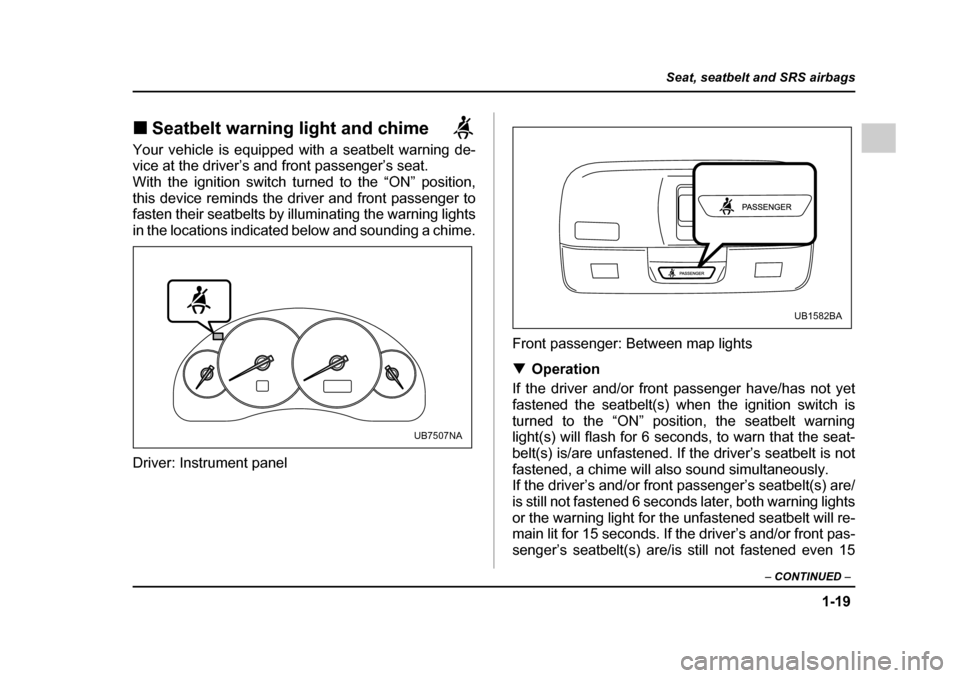
1-19
Seat, seatbelt and SRS airbags
– CONTINUED –
!Seatbelt warning light and chime
Your vehicle is equipped with a seatbelt warning de-
vice at the driver’s and front passenger’s seat.
With the ignition switch turned to the “ON” position,
this device reminds the driver and front passenger to
fasten their seatbelts by illuminating the warning lights
in the locations indicated below and sounding a chime.
Driver: Instrument panel Front passenger: Between map lights !
Operation
If the driver and/or front passenger have/has not yet
fastened the seatbelt(s) when the ignition switch is
turned to the “ON” position, the seatbelt warning
light(s) will flash for 6 seconds, to warn that the seat-
belt(s) is/are unfastened. If the driver’s seatbelt is not
fastened, a chime will also sound simultaneously.
If the driver’s and/or front passenger’s seatbelt(s) are/
is still not fastened 6 seconds later, both warning lights
or the warning light for the unfastened seatbelt will re-
main lit for 15 seconds. If the driver’s and/or front pas-
senger’s seatbelt(s) are/is still not fastened even 15
UB7507NA
UB1582BA